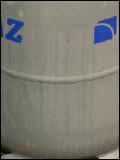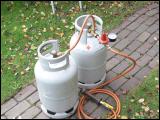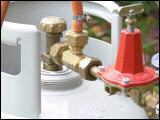Connector 2 Tanks - 1 Burner
A propane tanks contains liqified propane gas. During the firing proces this liquified gas needs to evaporate before it can flow throught the pressure regulator to the burner. This evaporation requiers heat and as we use gas during the time of firing the kiln this evaporation needs to be constant and it has to keep op with the increasing pressure hence gas demand of the burner.
After a short time of firing you can see already a layer of condensate at the outside of your tank. This is because the gas tank absorbes heat to enable the evaporation and because of that it gets colder than its environment. It is important now that sufficient heat is available to maintain the evaporation of gas and firing of the kiln.

In the event this heat is not or not sufficient available (Authum/Winter) then your gas tank will get colder and colder. The layer of condensate will turn into a layer of frost. The evaporation gets more and more difficult by the time you should have the peak pressure to get to the peak temperature. Eventually it can happen, when the situation gets really bad, that your tank totally freezes, by that time the firing process comes to an end in a big disappointment.
Never lay down a gas tank, keep that always in vertical position as intended. A certain volume of liquified propane turns into a ± 250 fold gas volume. It is not difficult to image the enormous amount of potential energy that is released when liquified gas passes the presurre regulator towards the burner.
With this connection hose you can connect 2 gas tanks to 1 burner. Doing so each tank only has to provide half of the gas quantity that the burder needs. That makes it easier for both tanks and give you less risk of firing problems. Specially with colder weather outside and/or when you fire quickly with little interval time for your tanks to adapt to normal ambient temperatures.

But also when do not have an immediate risk for freezing this connection hose can be usefull. Having two tanks connected to your burner you can use 1 of the tanks until it is completely empty. By the time that happens you simultanuously close the empty one and open the full one. With a bid of practice you can do this without disturbance of the firing process. Leave the empty tank connected until the firing is done and the full tank is closed as well.
The alternative is that you stop the firing, to dismantle the pressure regulator from the empty tank and connect it to a full one and having an interruption of the firing process.

(C) 2005 - All rights reserved